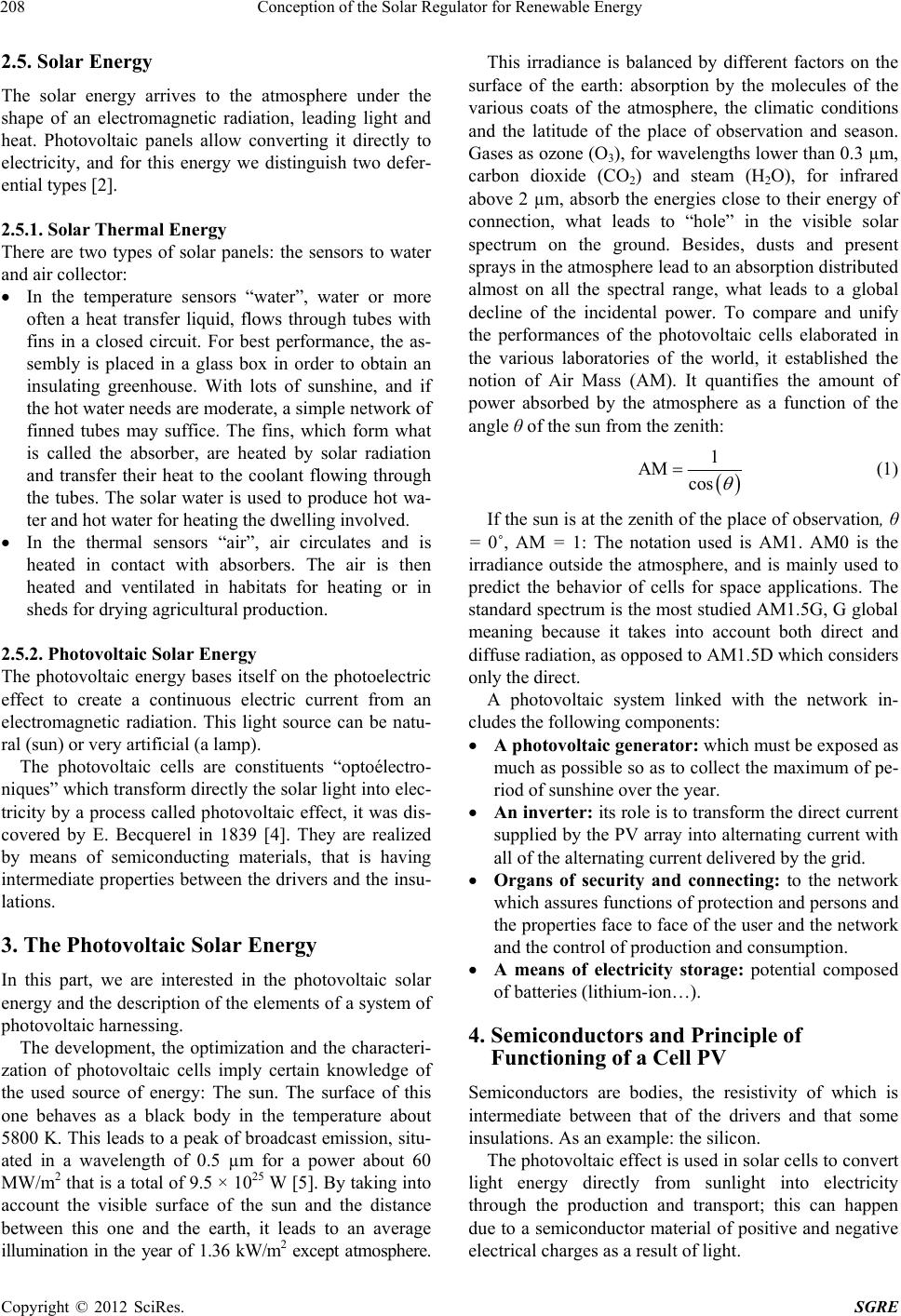
Conception of the Solar Regulator for Renewable Energy
208
2.5. Solar Energy
The solar energy arrives to the atmosphere under the
shape of an electromagnetic radiation, leading light and
heat. Photovoltaic panels allow converting it directly to
electricity, and for this energy we distinguish two defer-
ential types [2].
2.5.1. Solar Thermal Energy
There are two types of solar panels: the sensors to water
and air collector:
In the temperature sensors “water”, water or more
often a heat transfer liquid, flows through tubes with
fins in a closed circuit. For best performance, the as-
sembly is placed in a glass box in order to obtain an
insulating greenhouse. With lots of sunshine, and if
the hot water needs are moderate, a simple network of
finned tubes may suffice. The fins, which form what
is called the absorber, are heated by solar radiation
and transfer their heat to the coolant flowing through
the tubes. The solar water is used to produce hot wa-
ter and hot water for heating the dwelling involved.
In the thermal sensors “air”, air circulates and is
heated in contact with absorbers. The air is then
heated and ventilated in habitats for heating or in
sheds for drying agricultu ral production.
2.5.2. Photovoltaic Solar Energy
The photovoltaic energy bases itself on the photoelectric
effect to create a continuous electric current from an
electromagnetic radiation. This light source can be natu-
ral (sun) or very artificial (a lamp).
The photovoltaic cells are constituents “optoélectro-
niques” which transform directly the solar light into elec-
tricity by a process called photovoltaic effect, it was dis-
covered by E. Becquerel in 1839 [4]. They are realized
by means of semiconducting materials, that is having
intermediate properties between the drivers and the insu-
lations.
3. The Photovoltaic Solar Energy
In this part, we are interested in the photovoltaic solar
energy and the description of the elements of a system of
photovoltaic harnessing.
The development, the optimization and the characteri-
zation of photovoltaic cells imply certain knowledge of
the used source of energy: The sun. The surface of this
one behaves as a black body in the temperature about
5800 K. This leads to a peak of broadcast emission, situ-
ated in a wavelength of 0.5 µm for a power about 60
MW/m2 that is a total of 9.5 × 1025 W [5]. By taking in to
account the visible surface of the sun and the distance
between this one and the earth, it leads to an average
illumination in the year of 1.36 kW/m2 except atmosphere.
This irradiance is balanced by different factors on the
surface of the earth: absorption by the molecules of the
various coats of the atmosphere, the climatic conditions
and the latitude of the place of observation and season.
Gases as ozone (O3), for wavelengths lower than 0.3 µm,
carbon dioxide (CO2) and steam (H2O), for infrared
above 2 µm, absorb the energies close to their energy of
connection, what leads to “hole” in the visible solar
spectrum on the ground. Besides, dusts and present
sprays in the atmosphere lead to an absorption distribu ted
almost on all the spectral range, what leads to a global
decline of the incidental power. To compare and unify
the performances of the photovoltaic cells elaborated in
the various laboratories of the world, it established the
notion of Air Mass (AM). It quantifies the amount of
power absorbed by the atmosphere as a function of the
angle θ of the sun from the zenith:
1
AM cos
(1)
If the sun is at the zenith of the place of observation, θ
= 0˚, AM = 1: The notation used is AM1. AM0 is the
irradiance outside the atmosphere, and is mainly used to
predict the behavior of cells for space applications. The
standard spectrum is the most studied AM1.5G, G global
meaning because it takes into account both direct and
diffuse radiation, as opposed to AM1.5D which considers
only the direct.
A photovoltaic system linked with the network in-
cludes the following components:
A photovoltaic generator: which must be exposed as
much as possible so as to collect the maximum of pe-
riod of sunshine over the year.
An inverter: its role is to transform the direct current
supplied by the PV array into alternating curren t with
all of the alternating current delivered by the grid.
Organs of security and connecting: to the network
which assures functions of protection and persons and
the properties face to face of the user and the network
and the control of production and consumption.
A means of electricity storage: potential composed
of batteries (lithium-ion…).
4. Semiconductors and Principle of
Functioning of a Cell PV
Semiconductors are bodies, the resistivity of which is
intermediate between that of the drivers and that some
insulations. As an example: the silicon.
The photovoltaic effect is used in solar cells to con vert
light energy directly from sunlight into electricity
through the production and transport; this can happen
due to a semiconductor material of positive and negative
electrical charges as a result of light.
Copyright © 2012 SciRes. SGRE